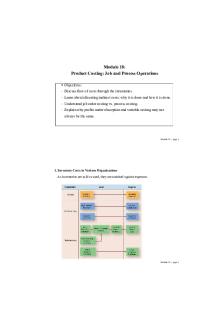Lecture Notes 18 PDF

| Title | Lecture Notes 18 |
|---|---|
| Course | Introduction to Environmental Science |
| Institution | Brandman University |
| Pages | 2 |
| File Size | 54.4 KB |
| File Type | |
| Total Downloads | 34 |
| Total Views | 143 |
Summary
These lecture notes were written for the ESCU 101 course taught by Professor Jeremy Kerr....
Description
Momentum Linear Momentum = mass x velocity p = m x v (kg m/s) Conservation of linear momentum - doesn't change unless an outside force is applied The symmetry of fireworks results from the conservation of momentum. When we add up all the pieces, they should cancel each other out and give a total momentum of zero. Angular Momentum Angular Momentum is also conserved. An object will keep spinning unless a twisting force (called a torque) acts to make it stop. The amount of angular momentum depends upon the rate of spin, amount of mass and the distribution of mass relative to the axis of rotation. Faster spin = greater angular momentum More mass, or mass located farther from central axis of rotation have greater angular momentum When the skater spins faster as she pulls in her arms, she is demonstrating the conservation of angular momentum. Newton's Law of Universal Gravitation Between any two objects in the universe there is an attractive force (gravity) that is proportional to the masses of the two objects and inversely proportional to the square of the distance between them. F = (G x m1 x m2 )/d2 G is the universal constant that applies everywhere in the universe (g applies only on Earth) G = 6.67 x 10-11 Nm2 /kg2 How can you use this equation to calculate your weight on the Moon? (What information will you need? Cavendish Balance Henry Cavendish measured the Universal gravitational constant (G) using this apparatus in 1798. (M) mass of stationary lead balls, (m) mass of movable lead balls, (F) gravitational force between each pair of balls, (θ) angle of deflection of balance from equilibrium position, (κ) torsion spring coefficient, (r) distance between centers of balls when balance is deflected (L) length of balance beam between centers of small balls. Henry Cavendish (1731-1810)
British scientist Discovered hydrogen (called it “inflammable air”) Measured the density of the Earth by his famous Cavendish experiment in which he calculated G. He was notoriously shy (likely fell somewhere on the autism spectrum) Halley's Comet In 1682, British astronomer Edmond Halley (1656-1742) used Newton's Laws to predict the orbit of what we now call Halley's Comet. He predicted it would return in 1758. It returned on Christmas Eve 1758 and was a worldwide triumph for the Newtonian system. Halley's comet on its last visit to Earth in 1985 Expected to return in 2061, it is the only short-period comet visible to the naked eye. (It returns every 75-76 years.) Sir Edmund Halley (1656-1742) English scientist best known for computing the orbit of Halley’s Comet He built a diving bell in 1691 and constructed a magnetic compass using liquid-filled housing to dampen the wobbles of a magnetized needle. In 1720 he and William Stukeley were the first to attempt to scientifically date Stonehenge. He was censored by the Royal Society in 1694 for suggesting that Noah’s flood may have been an account of a cometary impact. Chaos Theory Some natural systems do not obey Newton's Laws These are called “Chaotic Systems” Some examples include:
white-water streams
weather
Ecosystems In such systems we cannot predict outcomes even if we know all the forces acting in the system....
Similar Free PDFs

18 - Lecture notes 18
- 5 Pages

Chapter 18 - Lecture notes 18
- 21 Pages

Chapter 18 - Lecture notes 18
- 14 Pages

Module 18 - Lecture notes 18
- 41 Pages

Chapter 18 - Lecture notes 18
- 26 Pages

Research 18 - Lecture notes 18
- 5 Pages

Chapter 18 - Lecture notes 18
- 13 Pages

Lecture notes, lecture 1-18
- 26 Pages

Chapter-18 - Lecture notes
- 5 Pages

Lecture 18 Notes
- 6 Pages

Lecture Notes 18
- 2 Pages

Lecture 16-18 Notes
- 7 Pages

9 18 18 Ipats - Lecture notes 4
- 3 Pages

G1:S:G2 Phase 18 - Lecture notes 18
- 10 Pages
Popular Institutions
- Tinajero National High School - Annex
- Politeknik Caltex Riau
- Yokohama City University
- SGT University
- University of Al-Qadisiyah
- Divine Word College of Vigan
- Techniek College Rotterdam
- Universidade de Santiago
- Universiti Teknologi MARA Cawangan Johor Kampus Pasir Gudang
- Poltekkes Kemenkes Yogyakarta
- Baguio City National High School
- Colegio san marcos
- preparatoria uno
- Centro de Bachillerato Tecnológico Industrial y de Servicios No. 107
- Dalian Maritime University
- Quang Trung Secondary School
- Colegio Tecnológico en Informática
- Corporación Regional de Educación Superior
- Grupo CEDVA
- Dar Al Uloom University
- Centro de Estudios Preuniversitarios de la Universidad Nacional de Ingeniería
- 上智大学
- Aakash International School, Nuna Majara
- San Felipe Neri Catholic School
- Kang Chiao International School - New Taipei City
- Misamis Occidental National High School
- Institución Educativa Escuela Normal Juan Ladrilleros
- Kolehiyo ng Pantukan
- Batanes State College
- Instituto Continental
- Sekolah Menengah Kejuruan Kesehatan Kaltara (Tarakan)
- Colegio de La Inmaculada Concepcion - Cebu

